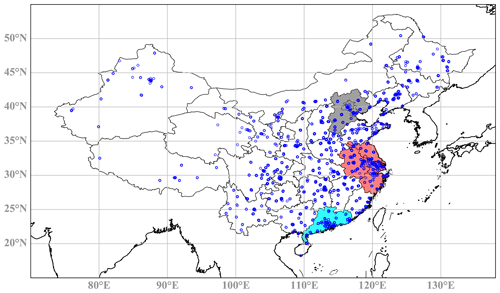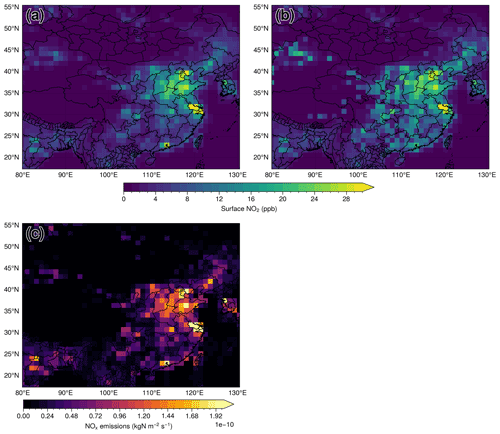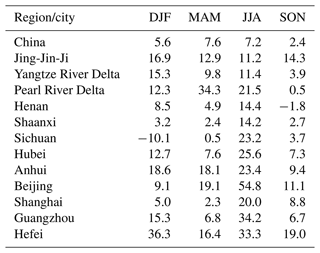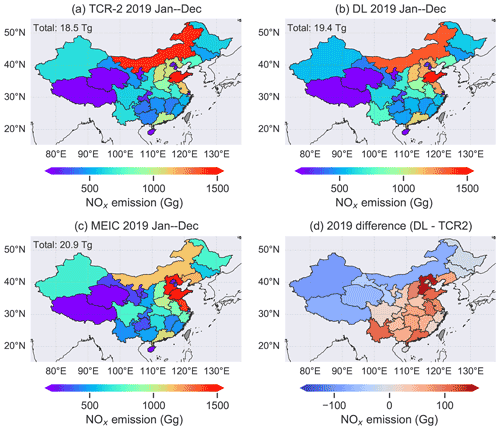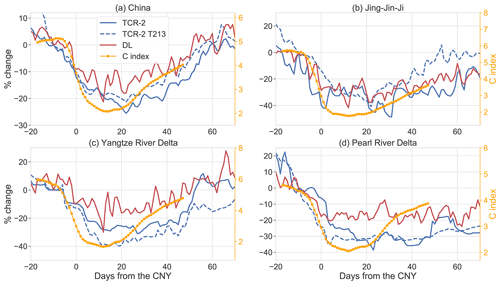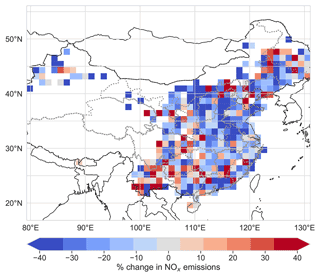the Creative Commons Attribution 4.0 License.
the Creative Commons Attribution 4.0 License.
Inverse modelling of Chinese NOx emissions using deep learning: integrating in situ observations with a satellite-based chemical reanalysis
Dylan B. A. Jones
Kazuyuki Miyazaki
Kevin W. Bowman
Zhe Jiang
Xiaokang Chen
Rui Li
Yuxiang Zhang
Kunna Li
Nitrogen dioxide (NO2) column density measurements from satellites have been widely used in constraining emissions of nitrogen oxides (NOx = NO + NO2). However, the utility of these measurements is impacted by reduced observational coverage due to cloud cover and their reduced sensitivity toward the surface. Combining the information from satellites with surface observations of NO2 will provide greater constraints on emission estimates of NOx. We have developed a deep-learning (DL) model to integrate satellite data and in situ observations of surface NO2 to estimate NOx emissions in China. A priori information for the DL model was obtained from satellite-derived emissions from the Tropospheric Chemistry Reanalysis (TCR-2). A two-stage training strategy was used to integrate in situ measurements from the China Ministry of Ecology and Environment (MEE) observation network with the TCR-2 data. The DL model is trained from 2005 to 2018 and evaluated for 2019 and 2020. The DL model estimated a source of 19.4 Tg NO for total Chinese NOx emissions in 2019, which is consistent with the TCR-2 estimate of 18.5 ± 3.9 Tg NO and the 20.9 Tg NO suggested by the Multi-resolution Emission Inventory for China (MEIC). Combining the MEE data with TCR-2, the DL model suggested higher NOx emissions in some of the less-densely populated provinces, such as Shaanxi and Sichuan, where the MEE data indicated higher surface NO2 concentrations than TCR-2. The DL model also suggested a faster recovery of NOx emissions than TCR-2 after the Chinese New Year (CNY) holiday in 2019, with a recovery time scale that is consistent with Baidu “Qianxi” mobility data. In 2020, the DL-based analysis estimated about a 30 % reduction in NOx emissions in eastern China during the COVID-19 lockdown period, relative to pre-lockdown levels. In particular, the maximum emission reductions were 42 % and 30 % for the Jing-Jin-Ji (JJJ) and the Yangtze River Delta (YRD) mega-regions, respectively. Our results illustrate the potential utility of the DL model as a complementary tool for conventional data-assimilation approaches for air quality applications.
- Article
(9106 KB) - Full-text XML
- BibTeX
- EndNote
Nitrogen oxides (NOx = NO + NO2) are a family of primary air pollutants that are directly involved in the formation of other air pollutants, such as tropospheric ozone and secondary inorganic aerosols. Emitted by anthropogenic and natural sources on the surface, NOx also has sources from lightning in the free troposphere (Murray, 2016). Satellite observations of tropospheric NO2 columns have been widely used during the past 2 decades to constrain NOx emissions (referred to as “top-down” emissions). Martin et al. (2003) used a mass balance approach with the GEOS-Chem global chemical transport model (CTM) to relate changes in the NO2 column to NOx emissions at the surface. They showed that the top-down analysis could reduce regional uncertainties in the a priori NOx emissions. Satellite-derived NOx emissions have been obtained by several subsequent studies using a similar mass balance approach (Bertram et al., 2005; Konovalov et al., 2006; Kim et al., 2006; Martin et al., 2006; Toenges-Schuller et al., 2006; Boersma et al., 2008). Advanced data-assimilation methods have also been applied to obtain satellite-based emission estimates of NOx. For example, the four-dimensional variational (4D-Var) method uses a CTM and its adjoint to propagate the differences between satellite data and simulation to the a priori estimate of NOx emissions (Müller and Stavrakou, 2005; Kurokawa et al., 2009; Chai et al., 2009; Qu et al., 2019). The Kalman filter is another widely used method, which employs information about the error covariance in the forecast of the trace gases to update atmospheric quantities in the CTMs (Napelenok et al., 2008; Miyazaki et al., 2020a; Wu et al., 2020).
Despite the range of inverse modelling approaches used to estimate NOx emissions from satellite observations, they all suffer from potential limitations associated with the CTMs employed in the inversion analyses. For example, Lin and McElroy (2010) found that a different scheme for mixing in the planetary boundary layer could lead to 3 %–14 % differences in the top-down NOx emission budgets for East China. Deep convective transport in the free troposphere, which can be challenging to accurately simulate, could vertically transport NO2 generated by lightning activities, which results in greater nonlinearity between NOx emissions and NO2 columns (Choi et al., 2005; Nault et al., 2017). The lifetime of NOx varies diurnally and seasonally, and discrepancies in the ability of a CTM to capture these variations will contribute to uncertainties in the top-down NOx emission estimates (Beirle et al., 2011; de Foy et al., 2014; Liu et al., 2016).
An additional limitation with the satellite-based top-down emission estimates of NOx is that NO2 is highly concentrated near the surface, whereas satellite measurements have lower sensitivity near the surface (Boersma et al., 2016). As a result, it is challenging for satellite observations to capture changes in surface NOx emissions. It has been suggested that satellite NO2 measurements are blending information from both surface emissions and atmospheric background of NO2 due to the low sensitivity of the satellite retrievals to NO2 near the surface (Li and Wang, 2019; Silvern et al., 2019; Qu et al., 2021). In situ observations of surface NO2 are more representative of local emissions, but typically have more limited observational coverage. As a result, combining the surface observations with the satellite data could offer greater constraints on NOx emission estimates.
Here we use a deep-learning (DL) model to indirectly integrate satellite data and in situ observations of surface NO2 to estimate NOx emissions in China. Deep-learning and other machine-learning models have been increasingly used in the field of atmospheric science (Rasp et al., 2018; He et al., 2022; Keller and Evans, 2019). These data-driven methods show high skill in capturing the nonlinear relationship between correlated atmospheric quantities. Compared to conventional data-assimilation systems, DL models are free of errors in chemistry and the potential errors associated with defective parameterization of subgrid-scale processes (Rasp et al., 2018). Moreover, high-resolution data assimilation using conventional approaches is computationally expensive, especially when dealing with large amounts of data, whereas DL models show much higher computational efficiency for high-resolution data-rich applications. In the present work, we use a DL model to estimate Chinese NOx emissions using surface NO2 concentrations. We train the DL model twice with different input information used in each training stage. We use the two-stage transfer learning strategy to integrate in situ NO2 observations from the China Ministry of Ecology and Environment (MEE) network with the Tropospheric Chemical Reanalysis (TCR-2) that assimilated satellite observations.
We focus on the 2019–2020 period, which overlaps with the COVID-19 pandemic that led to the lockdown of over one-third of Chinese cities in early 2020. Observations have shown significant reductions of atmospheric abundances of NO2 over China during this period (Bauwens et al., 2020; Liu et al., 2020). The change in atmospheric NO2 implies an anomalous change in emission of NOx, which provides a unique opportunity to evaluate the utility of the DL model for estimating NOx emissions. We evaluate the performance of the DL model by analysing the predicted NOx emissions for the normal year 2019 and the anomalous year 2020. Evaluation of the DL-based system utilized the dependent testing data set from the TCR-2 standard product (based on data from the Ozone Monitoring Instrument (OMI)), an updated higher-resolution TCR-2 product constrained by the TROPOspheric Monitoring Instrument (TROPOMI) measurements, and the independent Baidu “Qianxi” mobile data (Kraemer et al., 2020; Zhang et al., 2021).
The outline of the paper is as follows. Section 2 describes the data sets used in the analysis, the DL model, and the two-stage training strategy. Section 3 shows the results from the evaluation of the model performance after the two training stages and the analyses of the Chinese NOx emissions for 2019 and 2020. Conclusions are presented in Sect. 4.
2.1 TCR-2 data products
The TCR-2 chemical data set (Miyazaki et al., 2020a) was generated using a local ensemble transform Kalman filter (LETKF) data-assimilation system (Hunt et al., 2007), which optimizes both emissions and atmospheric abundance of various chemical species from the assimilation of multi-constituent measurements from multiple satellite instruments. The observational data are assimilated into the MIROC-CHASER global CTM (Sudo et al., 2002; Sekiya et al., 2018). The TCR-2 data product has a horizontal resolution of , and consists of 27 pressure levels from 1000 to 60 hPa. Details about the TCR-2 data-assimilation system can be found in Miyazaki et al. (2020a).
The TCR-2 NOx emissions were constrained in part by tropospheric NO2 column retrievals from the QA4ECV version 1.1 level 2 product for Ozone Monitoring Instrument (OMI) NO2 measurements (Boersma et al., 2018). The OMI is a spectrometer on board the NASA Aura spacecraft that was launched on 15 July 2004. It measures NO2 in the UV-VIS range of the spectrum, from which vertical column densities (VCD) of NO2 are retrieved. The OMI measurement strategy provides global coverage once per day. It should be noted that as a chemical data-assimilation system with detailed tropospheric chemistry, TCR-2 also relies on observational constraints from other NO2-related chemical species (e.g. tropospheric ozone) to optimize tropospheric NO2 and NOx emissions. For the analysis conducted here, the TCR-2 surface NO2 concentrations and NOx emissions were averaged to daily fields to train the DL model. In addition to the standard TCR-2 product, we also used an updated version of the TCR-2 products that assimilated tropospheric NO2 column retrievals from the TM5-MP-DOMINO data product version 1.2 for TROPOMI (van Geffen et al., 2020) at a higher spatial resolution of 0.5625∘ (referred to as the T213 product Miyazaki et al., 2020b, 2021). TROPOMI serves as the continuation and the next generation of the OMI sensor, monitoring air pollutants at a much higher horizontal resolution (7 km × 3.5 km at nadir), and data have been available since February 2018. Since the TROPOMI-based TCR-2 T213 product is only available for the last few years of the analysis period considered here, we use it as an independent data set in the evaluation of the DL model for the year 2020.
2.2 MEE network
As part of the Chinese government's Air Pollution Control Action Plan, the Ministry of Ecology and Environment (MEE) of the People’s Republic of China (PRC) have been deploying ground-based stations to monitor air pollution since 2013. Surface NO2 concentration measurements are archived at an hourly frequency, at more than 1500 ground-based stations as of 2019. The NO2 concentrations are measured and reported in micrograms per cubic metre (µg m−3). Special attention is given to the reference state for unit conversion. Until 31 August 2018, the reference state for in situ measurements was 273 K and 1013 hPa, after which it was changed to 298 K and 1013 hPa. To simplify the integration of the MEE data with the TCR-2 data, the in situ measurements were aggregated to the grid of the TCR-2 system using the nearest neighbour interpolation method. The locations of the MEE sites as of 2019 are shown in Fig. 1. The MEE network has good coverage over eastern and central China. For western and northeastern China, the spatial coverage is lower. Han et al. (2022) investigated the impact of observational coverage by removing 10 % of the grid-averaged observations from the training of a similar DL model and found no noticeable performance degradation in the evaluation of the DL model over these regions. However, the low station densities in some grids could lead to representation errors in the aggregated observations. The MEE network includes both urban and rural sites and we included data from all sites to increase observational coverage and mitigate representation errors. The MEE measurements are made using a chemiluminescence analyser with a molybdenum converter that results in an overestimation of NO2 (Lamsal et al., 2008). Following Lamsal et al. (2008), we used the GEOS-Chem model to simulate NOx, HNO3, peroxyacetyl nitrate (PAN), and alkyl nitrates (AN) to produce correction factors (CFs) for the measurements using the following relationship:
where ∑AN is the sum of all ANs. We used version 12.0.2 of GEOS-Chem at a resolution of to estimate monthly mean CFs for 2015. The simulation was conducted with full chemistry and the MIX inventory (Li et al., 2017). The annual total Chinese emissions in the simulation was 19.0 Tg NO, which is consistent with TCR-2 estimates. These 2015 CFs were regridded to the resolution of the DL model and applied to the MEE measurements for 2014–2020. The CFs were close to unity in high emission regions, such as in eastern China, but could be as small as 0.4 in rural regions.
2.3 Baidu “Qianxi” mobile data
The Baidu “Qianxi” mobile data are generated from the Baidu map service, which is widely used in China as an equivalent to Google maps. It quantifies the intensity of human mobility as an immigration index (I-index), an emigration index (E-index), and an intra-city index (C-index). These migration indices have been used by other studies and are shown to have good correlation with human activities (Wei and Wang, 2020; Kraemer et al., 2020; Zhang et al., 2021). The C-index measures the movement of people out of their homes in the city, reflecting intra-city movement, and is thus a proxy of human activity. Zhang et al. (2021) found that the C-index showed much higher correlation with variations in surface NO2 concentration than the other two indices (the I-index and the E-index). They found that about 40 % of the variance of emission-based NO2 reductions in 29 megacities (with populations over 8 million) in China could be explained by the C-index. For some megacities in southern China, the variance explained by the C-index was as large as 70 %. The Zhang et al. (2021) results suggest that human mobility can provide a proxy for NOx emissions. We therefore use the C-index here as the independent data set to evaluate the DL model.
2.4 Deep-learning (DL) model and input variables
The DL model used here is built using convolutional neural networks (CNNs) (LeCun et al., 2015) and long short-term memory (LSTM) units (Hochreiter and Schmidhuber, 1997). Figure 2 shows a schematic diagram of the model. The hybrid architecture was previously used for predicting summertime surface ozone concentrations in the United States in He et al. (2022). The DL model showed great predictive skill in capturing the nonlinear relationship between the predictors and the model output. This DL architecture is applied here for estimating Chinese NOx emissions using surface NO2 concentrations and meteorological variables as input predictors. The input variables are forwarded to three sequential convolutional blocks. Each convolutional block consists of two CNN layers and one max-pooling layer. Each CNN layer uses filters that are 3×3 in size to apply convolutional operations with the data vectors and output so-called latent vectors. The softplus function is applied to activate the output from each CNN layer to increase the nonlinearity of the DL architecture. The max-pooling layers further condense the dimension of the latent vectors by taking the maximum values within 2×2 windows. The first three convolutional blocks were used as an encoder for the extraction of spatial features hidden in the input information. The output of the last convolutional block was a highly compressed and reshaped latent vector with a size of 30×1024, which was then forwarded to two LSTM cells, which are recurrent neural networks (RNNs), with 1024 units to learn the dynamics. The LSTM cell is followed by three up-convolutional layers and seven convolutional layers. The up-convolutional layers use 2×2 convolutional filters to up-sample the latent vectors to high-resolution outputs. We applied residual learning connections (the arrows in Fig. 2), which stabilize the performance of the U-net model (Li et al., 2018; He et al., 2016). We used the Adam optimizer for boosted optimization of the U-net model (Kingma and Ba, 2014). The DL model was run on the NVIDIA T4 tensor core graphics processing unit (GPU) on the Graham supercomputer of Compute Canada. During the training process, the convolutional filters, the weight matrices, and bias vectors in the LSTM were iteratively optimized using a back-propagation algorithm. The initial learning rate was for both training stages, and the residual sum of squares was used as the loss function. Other hyper-parameters for the training of the model include the number of epochs, which was 250, and the batch size, which was 30.
The meteorological variables were taken from the ERA5 data product, which is different from the ERA-Interim data product used in the TCR-2 data-assimilation system. We chose the more recent ERA-5 product because of its higher spatial and temporal resolution, which better represents mesoscale to synoptic-scale transport processes (Hoffmann et al., 2019). This could be advantageous for the Stage 2 training, where the MEE in situ observations are used to improve the NO2–NOx relationship. Table 1 lists the chosen input variables for the U-net model. We treated information of surface NO2 from days t and t−1 as different channels in the input layer. Considering the short lifetime of surface NOx, we did not include meteorological variables from day t−1. We included surface NO2 from days t and t−1 for better prediction of NOx emissions. All the input variables are regridded to the grid of TCR-2 using the first-order conservative remapping algorithm. As mentioned above, the output of the DL model, which is NOx emissions, is at the same grid. To ensure stability of the training of the DL model, all the input variables were scaled to make sure the values are within a relatively similar range. Table 1 gives the details about the input variables selected for the NOx emission inversions.

Figure 2Schematic representation of the U-net model for the prediction of Chinese NOx emissions. The CNN layers with 3×3 filters are shown in orange. The dark orange regions indicate the application of softplus activation functions. The 2×2 max-pooling layers are shown in red. The two green circles represent the LSTM cells. The 2×2 up-convolutional layers are shown in light blue, which are concatenated (indicated as grey boxes) with the transferred latent vectors (shown as dark blue boxes) from the encoder. The arrows indicate the residual connections.
Table 1Input variables for NOx emission inversion using the DL model.
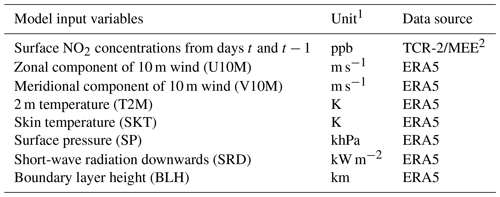
1 Units of the raw data could be different from these units. Multiplicative scaling is done to match these units before being used by the U-net model. 2 TCR-2 surface NO2 concentrations are used for the first training stage. The MEE in situ NO2 measurements are added in the second training stage.
2.5 Two-stage training strategy
For the integration of the MEE in situ data with the TCR-2 data, we use a two-stage transfer learning strategy (Zhuang et al., 2021), as depicted in Fig. 3. The first training stage focuses on the TCR-2 NO2 concentration and NOx emission relationship. In this training stage, we train the model using the TCR-2 data pairs of NO2 and NOx, together with the ERA5 meteorological predictors. The purpose of this training stage is to supervise the DL model with the prior knowledge of the relationship between surface NO2 concentrations and NOx emissions from the TCR-2 system. The goal here is to train the DL model to reproduce the TCR-2 NOx emissions, given the TCR-2 surface NO2 data. The second training stage is conducted based on the pre-trained DL model from Stage 1. This stage utilizes the transferred TCR-2 knowledge and the pre-trained DL model weights to provide an initial model state for Stage 2. In this second stage, the MEE NO2 data are integrated with the TCR-2 surface NO2 data and the model retrained with the combined data set. The purpose of Stage 2 is to improve the relationship between surface NO2 and NOx emissions acquired from TCR-2, given the available surface NO2 observations. Figure 4 shows the annual mean NO2 concentrations from TCR-2 and MEE for 2019 and the mean TCR-2 NOx emissions for 2019. The distributions of surface NO2 and NOx are spatially consistent. Compared to surface NO2 used in Stage 1 training, the MEE in situ measurements add more information to the Stage 2 training. The TCR-2 standard data product spans from 2005 to 2020, whereas the MEE measurements are available from the beginning of 2014. Therefore, we train the DL model from 2005 to 2018 for Stage 1, and from 2014 to 2018 for Stage 2. The evaluation of the DL model is conducted for 2019 and 2020. Due to the impact of the COVID-19 pandemic, year 2020 is anomalous as compared to the training set with normal years. The mean TCR-2 Chinese NOx emissions for the first 115 d in 2020 are 10 % and 23 % lower than the same period in 2005 and 2014, respectively, and the change in emissions was faster than at any point in the training set. Thus, by including 2020 in the testing period, we examined the capability of the U-net model to extrapolate the training sample.

Figure 3The two-stage training strategy used to integrate the in situ data with the TCR-2 data. In Stage 1, only the ERA5 meteorological fields and the TCR-2 surface NO2 data (represented by the orange boxes) are used as predictors in training the model (indicated by the yellow symbols) to predict NOx emissions (indicated by the green box). In Stage 2, the two surface NO2 predictors (for days t and t−1) are replaced by the MEE in situ NO2 measurements (denoted by the red box) with data gaps filled with the TCR-2 NO2. Meteorological variables remain the same in both training stages.
3.1 Analysis of the DL emission in 2019, during the testing period
A comparison of the Stage-1 DL analysis and the TCR-2 NOx emissions for 2019 is shown in Fig. 5. The DL-estimated daily NOx emissions are in good agreement with the TCR-2 “truth” after the first training stage, with a correlation coefficient of 0.96 and a slope of 1.02. The annual mean errors in the DL-estimated NOx emissions are within 10 %. These results indicate that the DL model captured well the relationship between surface NO2 and NOx emissions from TCR-2 after the first training stage. The time series of estimated NOx emissions for three metropolitan regions, five selected provinces, and four major cities in China are plotted in Fig. 6. As can be seen after Stage 1, the DL model agrees well with the TCR-2 emissions in most regions. Even on small scales such as Beijing, which is only one grid box at the 1.1∘ resolution, the inferred emissions after Stage 1 are consistent with the TCR-2 emissions. The largest discrepancies after Stage 1 are found in the coastal regions of the Pearl River Delta (PRD) and the Yangtze River Delta (YRD), which encompass the cities of Guangzhou and Shanghai, respectively, (see Fig. 1 for the locations of the PRD and YRD regions).

Figure 5Correlation between daily NOx emissions from the TCR-2 estimates and the DL analysis for 2019 (the testing period).
The difficulty of the DL model in reproducing the TCR-2 emissions in the coastal regions, particularly in the PRD, could reflect issues in both TCR-2 and the DL model. In the coastal regions in southern China, cloud cover will result in significantly reduced observational coverage from the satellites, which would impact TCR-2. For example, in the PRD (and Guangzhou), TCR-2 exhibits periods, such as around days 50 and 100, with anomalously low and constant NOx emissions, which could be due to reduced observational coverage. In addition, although both the PRD and the YRD experience heavy rainfall during the monsoon season, Luo et al. (2013) found that the PRD experience more frequent mesoscale convective systems and greater rainfall accumulation than the YRD, which they attributed to the mountainous topography of the PRD and the nearby ocean, in contrast to the more flat YRD. It is possible that at a resolution of , both TCR-2 and the DL model cannot capture the complex meteorology (e.g. the sea breeze circulation and its model errors) in the PRD and its impact on the trace gas distribution, and thus are unable to reproduce the appropriate relationship between the NOx emissions and the atmospheric NO2 concentrations.
After Stage 2, the NOx emissions calculated by the DL model are still consistent with the TCR-2 emissions in the main source emission regions. For Jing-Jin-Ji (JJJ), the DL emissions are 13.8 % higher than the TCR-2 emissions, while for the YRD, the DL emissions are 10.0 % higher. The seasonal differences in the estimated emissions are given in Table 2. In JJJ, the differences between the DL and TCR-2 emissions are relatively constant throughout the year, whereas for the YRD the differences are small in autumn and larger in winter. In general, we find that the DL model suggests modest increases in emissions in central and eastern China, with relatively larger increases in the less-densely populated provinces, such as Sichuan. In Sichuan, the estimated DL emissions are 23.2 % higher than those in TCR-2 in summer. Comparison of the emissions after Stages 1 and 2 in Fig. 6 shows that these large increases were produced after incorporating the MEE data in Stage 2. Thus, it is helpful to compare the time series of the TCR-2 and MEE surface NO2 data, which are plotted in Fig. 7. In Sichuan, the MEE observations suggest significantly higher surface NO2 abundances, which could account for the higher DL emission estimates. For JJJ and the YRD, the TCR-2 NO2 is in good agreement with the MEE data.
To further evaluate the estimated NOx emissions, in Fig. 8 we compare the 2019 TRC-2 and DL emissions with the recently updated Multi-resolution Emission Inventory for China (MEIC) (Zheng et al., 2021). For total Chinese emissions, there is good consistency between the three inventories, with TCR-2, the DL model, and MEIC suggesting total Chinese emissions of 18.5 ± 3.9, 19.4, and 20.9 Tg NO, respectively. However, despite the good agreement on the national scale, there are regional differences between the inventories. Compared to TCR-2, MEIC suggested higher NOx emissions in JJJ and in the Jiangsu province (the northeastern part of the YRD). The DL-estimated emissions are higher than TCR-2 in these regions, but lower than those of MEIC. In Inner Mongolia, both TCR-2 and the DL model infer higher emissions than MEIC, with the DL model suggesting more emissions than MEIC and less than TCR-2. For the PRD, TCR-2 NOx emissions are slightly lower than MEIC, whereas the DL results are slightly higher than MEIC. In less-densely populated regions, such as Sichuan and Yunnan provinces, the DL-estimated NOx emissions are higher than both TCR-2 and MEIC.
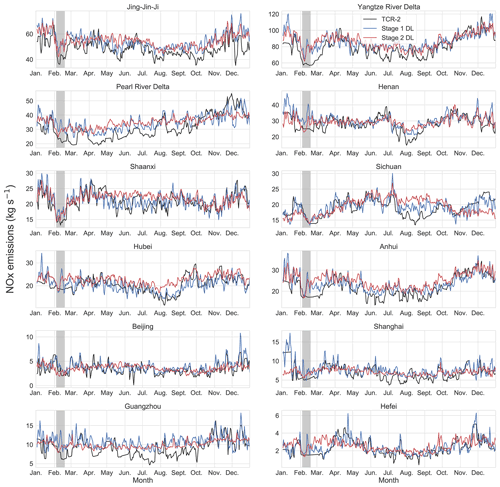
Figure 6Time series of daily mean NOx emissions in 2019 for three Chinese metropolitan regions (Jing-Jin-Ji, the Yangtze River Delta, and the Pearl River Delta), five selected provinces (Henan, Shaanxi, Sichuan, Hubei, and Anhui), and four major cities (Beijing, Shanghai, Guangzhou, and Hefei) for 2019 (the testing period). Shown are the emissions from the TCR-2 estimates (black) and the DL analysis after Stage 1 (blue) and Stage 2 (red). The shaded areas represent the 14 d period after the Chinese New Year.
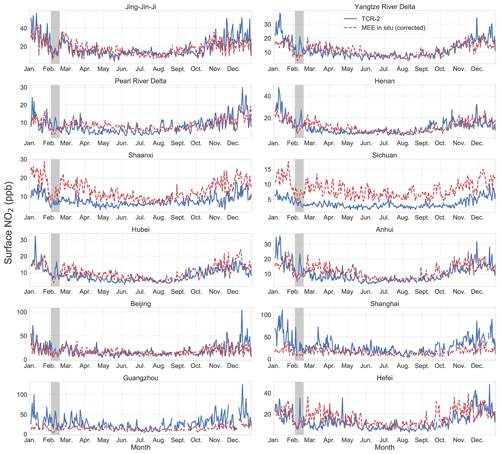
Figure 7Time series of daily mean surface NO2 concentrations in 2019 for the three Chinese metropolitan regions, selected provinces, and major cities shown in Fig. 6. The corresponding TCR-2 NO2 data sampled at MEE sites are shown in blue, whereas the MEE ground-based NO2 observations are indicated by the dashed red line. The shaded areas represent the 14 d period after the Chinese New Year.
3.2 Recovery of NOx emissions after the Chinese New Year (CNY) holiday in 2019
Chinese NOx emissions typically decrease around January and February every year due to reduced human activity during the Chinese New Year (CNY) holidays. After the 1-week holiday, Chinese NOx emissions gradually recover to pre-holiday levels. This annual variation in NOx emissions is well captured by TCR-2, as shown in Fig. 9. Starting from 10 d before the holidays, the Chinese NOx emissions decrease rapidly by 20 % relative to emissions 20 d before the CNY, reaching a minimum shortly after the CNY. The interannual spread in TCR-2 emissions was about ±5 % for the 2005–2019 period, as similarly demonstrated by Miyazaki et al. (2020b), and the 2019 NOx emissions were consistent with the multi-annual mean. The CNY-related variation in NOx emissions was captured in TCR-2 in all three of the mega-regions: Jing-Jin-Ji (JJJ), the Yangtze River Delta (YDR), and the Pearl River Delta (PRD).
The DL analysis from Stage 2 was in good agreement with the TCR-2 emission estimates before the 2019 CNY for China and for the JJJ and YRD regions. However, after the holiday, the DL-based NOx emissions recovered 50 % of the post-holiday reductions within 10–20 d, which was faster than in TCR-2 NOx. The faster recovery in the DL-based NOx emissions can be clearly seen for China and the YRD. The largest discrepancy between the DL model and TCR-2 was for the PRD region, where the variations in the DL-based NOx emissions did not match that in TCR-2 before nor after the CNY. For example, TCR-2 exhibited large variations in the emissions, which the DL model does not capture. As discussed above, the DL model has difficulty reproducing the TCR-2 emissions in the PRD throughout 2019, even after Stage 1 of the training, when the model is trained solely on TCR-2 data, so the discrepancy between TCR-2 and the DL model in the signal of the CNY in the PRD emissions is consistent with the results shown in Fig. 6.
To validate the faster post-holiday recovery in the DL-based NOx emissions, we use the C-index from the Baidu “Qianxi” data, which is also shown in Fig. 9. During the 2019 CNY period, the average C-index over the whole country rapidly decreased by 10 % from 4.5 to 4.1. It should be noted that the relationship between the C-index and NOx emissions is not linear, as a 20 % decrease in NOx emissions does not necessarily correspond to a comparable decrease in the C-index. However, as a measure of human activity and a proxy for NOx emissions, the timing of the recovery in the C-index could provide useful information to evaluate the performance of the models in capturing the relative variations in NOx emissions, especially from transportation source sectors. As shown in Fig. 9, the faster recovery of the DL model is consistent with the C-index. This is particularly evident for China, JJJ, and the YRD. Figure 10 shows the estimated time (in days) for the DL model, the TCR-2 NOx emissions, and the C-index to recover to 50 % of the averaged values 5 d before the CNY for China, the three Chinese mega-regions, and all Chinese provinces. For all provinces, the recovery of the C-index took 9.5±5.2 d after the CNY (Fig. 10b). In comparison, the recovery of the NOx emissions in the DL model and TCR-2 took 14.4±8.4 and 23.0±11.1 d, respectively. For JJJ and the YRD, the DL model suggested a recovery time of 15 and 16 d, respectively, whereas the C-index recovery took 9 d (Fig. 10a). For the PRD, the DL model recovered after 15 d, whereas the C-index recovered after 18 d.
The validation of the DL estimates here provide insights about the limitations of the satellite-derived NOx emissions. Insufficient space-based observational constraints can limit the representation of short-term changes in NOx emissions. The OMI observational coverage is limited, especially during winter over China due to cloudy or rainy conditions, and the relatively large retrieval uncertainty could prevent rapid a posteriori emission changes in the top-down analysis. This limitation could be mitigated by further optimization of the background error covariances in the top-down analysis to better reflect individual measurements. In addition, the use of more dense and accurate observations, such as from TROPOMI (see Sect. 3.3) could provide an improved representation of daily emission changes.
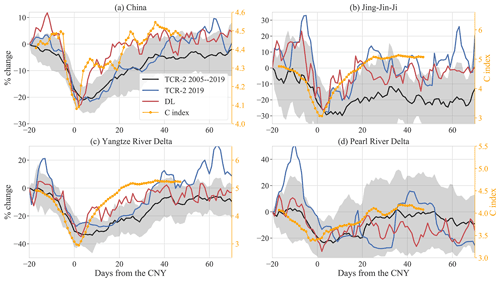
Figure 9Time series of the percentage change in Chinese NOx emissions and the C-index Baidu mobile data as a function of days from the CNY. The differences are plotted relative to 20 d before the 2019 CNY. Shown are time-series comparisons for (a) China, (b) the Jing-Jin-Ji region, (c) the Yangtze River Delta region, and (d) the Pearl River Delta region. The black line represents the TCR-2 mean for 2005–2019. The C-index is smoothed by a 7 d window to remove weekly variability.
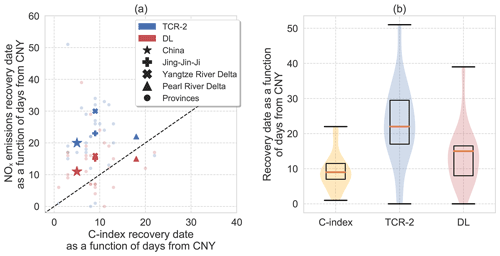
Figure 10Comparison of the timing of the recovery of the NOx emissions and Baidu C-index data back to 50 % of the averaged values 5 d before the CNY in 2019. (a) The scatter plot of NOx emission recovery dates versus the C-index recovery dates. Each circle represents a province and special markers correspond to the larger regions as indicated by the legend. (b) Box whisker plots and the normalized distribution of the recovery dates for the C-index, TCR-2 NOx emissions, and the DL-based NOx emissions, calculated based on all provinces in China.
3.3 Analysis of the 2020 COVID-19 pandemic period
Since the COVID-19 pandemic lockdown led to a significant and unexpected perturbation to human activity, we examine the ability of the DL model to quantify changes in NOx emissions during the lockdown period in China in 2020. Here we use the TROPOMI-based higher-resolution analysis using TCR-2 (hereafter referred to as T213 data) as an independent data set for the evaluation of the DL model. The standard OMI-based TCR-2 data product is hereafter referred to as T106 data. The T213 data were used to study detailed spatial and temporal changes in NOx emissions during the COVID-19 lockdown period (Miyazaki et al., 2020b, 2021). The T213 product is expected to better capture variability in NOx emissions, compared to the T106 product, because of the greater observational constraints from TROPOMI and the higher spatial resolution and coverage. The time series of the relative changes in NOx emissions around the 2020 CNY are shown in Fig. 11. We choose the reference date to be 10 d before the 2020 CNY to avoid spin-up issues in the T213 data. On the national scale, all three NOx emission estimates decreased at roughly the same rate until about 10 d after the 2020 CNY, after which the DL-based emission began increasing. The T106 and T213 NOx emissions continued to decrease for about an additional 10 d after the CNY, with the T213 data suggesting a smaller overall reduction than T106. All three NOx emission estimates suggested that a full recovery took 60 d after the CNY. However, of the three, the DL-based estimates suggested the smallest overall reduction in Chinese NOx emissions. For JJJ, the DL-based and T106 emissions estimates were fairly consistent, but the T213 estimates suggested a faster recovery.
Comparison of the NOx emission time series with the C-index in Fig. 11 shows distinct differences in the timing of the minimum in the data after the 2020 CNY. As noted above, we do not expect there to be a linear relationship between the C-index and the NOx emissions, but since the reduction in emissions is in part driven by the lockdown, we anticipate that the minimum in the migration data should closely correspond to the minimum in emissions. For China, as listed in Table 3, the C-index reached a minimum 14 d after the CNY, whereas the DL model, the T213 data, and the T106 data reached a minimum within 13, 21, and 23 d, respectively. The DL model reproduced well the timing of the minimum for JJJ and the YRD. However, it significantly underestimated the timing for the PRD (3 d for the DL model compared to 12 d for the C-index). But as we noted above, the DL model has difficulty simulating the PRD, and the timing of the minimum for the PRD is not well defined, as the signal is noisy and exhibits a fairly broad minimum. We find that the timing of the minima in the T213 emissions more closely match that of the C-index than T106, which suggested delayed minima.
The timing of the recovery of the post-holiday reductions to 50 % of the averaged values 5 d before the holiday for the C-index and the estimated NOx emissions are listed in Table 4. For China, the C-index took 31 d to recover in 2020, whereas the DL model and the T213 data took 31 and 37 d, respectively, to recover. The recovery time in T106 data was 41 d. For JJJ, the time required for the 50 % recovery was 34 d for the C-index, whereas for the DL model, the T213 data, and the T106 data it was 34, 36, and 31 d, respectively. For the YRD, both reanalysis data products took over 40 d to recover, which is more than 20 d longer than the C-index and more than 10 d longer than the DL model. In the PRD, all of the estimated NOx emissions took more than 20 d longer to recover than the C-index.
The spatial distribution of the DL-estimated changes in Chinese NOx emissions 20–30 d after the 2020 CNY, relative to 10–20 d prior to the CNY, are shown in Fig. 12. The DL analysis shows over 30 % reduction in NOx emissions 20–30 d after the 2020 CNY for the heavily polluted regions in northern and eastern China. In JJJ, the DL analysis suggested a maximum reduction in NOx emissions of 42 % during the lockdown period, whereas the T106 and T213 data indicated a maximum reduction of 49 % and 41 %, respectively. Using a regional model to assimilate the MEE data to estimate NOx emissions for January–March 2020, Feng et al. (2020) estimated a reduction of 42 % in NOx emissions for JJJ. For the YRD, the DL model and the T106 data suggested comparable reductions of 30 % and 31 %, respectively, which were roughly 10 % smaller than the reductions in the T213 data and in Feng et al. (2020) of 40 % and 41 %, respectively. The comparison here shows that the impact of the lockdown on NOx emissions in the higher-resolution T213 data, in contrast to the T106 data, is more consistent with Feng et al. (2020). This confirms that the emission analysis at T106 resolution (1.1∘) constrained by the OMI measurements may not provide sufficient information to capture rapid regional variations in NOx emissions. The four analyses exhibited the largest disagreement in the PRD, where Feng et al. (2020) estimated a 50 % maximum reduction in emissions, whereas the T106 and T213 data suggested maximum reductions of 39 % and 35 %, respectively. The DL model significantly underestimated the emission reduction in the region, with a maximum reduction of 24 %. Overall, the comparison with the migration data and with the Feng et al. (2020) results indicate that, with the exception of the PRD, integrating the MEE and TCR-2 data results in an improved relationship between surface NO2 concentrations and NOx emissions.
Table 3Timing (in days) of the minimum in the migration data and NOx emissions during 30 d after the 2020 CNY.

Table 4Time (in days) for the migration data and NOx emissions to recover to 50 % of the pre-CNY level in 2020.

We developed a DL model to estimate Chinese NOx emissions using surface NO2 concentration and meteorological predictors, based on the integration of MEE in situ NO2 observations with TCR-2 NO2. To that end, we applied a multistage training strategy for the transfer learning of the chemical relationship between surface NO2 and NOx emissions in the TCR-2 data set. We found that the integration of the MEE in situ data with TCR-2 suggested NOx emissions from China for 2019 to be 19.4 Tg NO, which is consistent with the 18.5 ± 3.9 Tg NO estimated by TCR-2. The DL model and TCR-2 were both consistent with the suggested Chinese source of 20.9 Tg NO in the MEIC inventory (Zheng et al., 2021). For the JJJ and YRD mega-regions in China, the DL-based NOx emissions were higher than TCR-2 by 13.8 % and 10.0 %, respectively. The DL model particularly increased emissions in the less-densely populated provinces, where the MEE observations indicated higher surface NO2 abundances than in TCR-2. He et al. (2022) suggested that inversions using satellite observations to estimate NOx emissions have the potential to blend information from background NOx and surface emissions at coarse spatial resolutions. It is possible that much higher resolution than the of TCR-2 is needed for the satellite-based assimilation system to capture the surface NO2 signal in these less-densely populated provinces. We also found that the DL model could not reproduce the TCR-2 relationship between NOx emissions and surface NO2 in the PRD, and integration of the MEE data resulted in large adjustments in the NOx emissions in the region. During the monsoon season, southern China experiences heavy and frequent rainfall, and the mountainous topography of the PRD and its proximity of the ocean could make it challenging for TCR-2 and the DL model to accurately account for the influence on surface NO2 of the complex meteorology in the region at a resolution of .
Analysis of the DL-based NOx emissions focused around the CNY holiday in 2019 showed a faster recovery of the Chinese NOx emissions after the 2019 CNY, which was consistent with the Baidu “Qianxi” mobile data (Kraemer et al., 2020; Zhang et al., 2021). During the 2020 lockdown period for the COVID-19 pandemic, the DL model estimated maximum reductions in NOx emissions – 42 % for JJJ and 30 % for the YRD. These estimates were consistent with the TCR-2 T106 data (with reductions of 49 % for JJJ and 31 % for the YRD), the high-resolution TCR-2 T213 data (with reductions of 41 % for JJJ and 40 % for the YRD), and with Feng et al. (2020) (who estimated reductions of 42 % for JJJ and 41 % for the YRD). For the PRD, the DL model estimated a significantly smaller maximum reduction in NOx emissions of 24 %, which is likely due to the model bias in the region.
The analysis during the 2020 lockdown period showed that the DL model has the ability to extrapolate outside the regime of the training data set. Our results showed the potential of this DL model as a good complementary tool for conventional data-assimilation approaches. The flexibility of the model is such that it could be adapted to provide near-real time estimates of NOx emissions for air quality forecasts and chemical reanalysis systems. The high computational efficiency of the DL model in integrating large amounts of observational data from multiple sources would be advantageous in the emerging era with geostationary satellites that will significantly enhance observational coverage for air quality applications.
The code for this study can be found at https://github.com/tailonghe/Unet_Chinese_NOx (last access: 25 October 2022) (DOI: https://doi.org/10.5281/zenodo.7145714, He, 2022). The TCR-2 data could be accessed from https://doi.org/10.25966/9qgv-fe81 (Miyazaki et al., 2019). The ERA5 climate reanalysis data are available from ECMWF https://doi.org/10.24381/cds.adbb2d47 (Hersbach et al., 2018). The MEE in situ observations could be downloaded from https://doi.org/10.5281/zenodo.5030857 (Jiang, 2021). The Baidu “Qianxi” mobile data were originally retrieved from the Baidu “Qianxi” website (http://qianxi.baidu.com/, last access: December 2021) and processed in Zhang et al. (2021).
TLH and DBAJ designed the research study; TLH built and trained the model; TLH and DBAJ performed the research and analysed the results; TLH, DBAJ, KM, KWB, ZJ, XC, and YZ contributed to revising and editing the manuscript; TLH, KM, XC, RL, YZ, and KL processed the data sets.
The contact author has declared that none of the authors has any competing interests.
Publisher’s note: Copernicus Publications remains neutral with regard to jurisdictional claims in published maps and institutional affiliations.
Computations were performed on the Graham supercomputer of Compute Ontario and Compute Canada.
This work was supported by the Natural Sciences and Engineering Research Council of Canada (grant no. RGPIN-2019-06804). Part of this work was conducted at the Jet Propulsion Laboratory, California Institute of Technology, under contract with the National Aeronautics and Space Administration (NASA, grant no. TROPESS, grant no. 19-AURAST19-0044).
This paper was edited by Jerome Brioude and reviewed by two anonymous referees.
Bauwens, M., Compernolle, S., Stavrakou, T., Müller, J.-F., van Gent, J., Eskes, H., Levelt, P. F., van der A, R., Veefkind, J. P., Vlietinck, J., Yu, H., and Zehner, C.: Impact of Coronavirus Outbreak on NO2 Pollution Assessed Using TROPOMI and OMI Observations, Geophys. Res. Lett., 47, e2020GL087978, https://doi.org/10.1029/2020GL087978, 2020. a
Beirle, S., Boersma, K. F., Platt, U., Lawrence, M. G., and Wagner, T.: Megacity Emissions and Lifetimes of Nitrogen Oxides Probed from Space, Science, 333, 1737–1739, https://doi.org/10.1126/science.1207824, 2011. a
Bertram, T. H., Heckel, A., Richter, A., Burrows, J. P., and Cohen, R. C.: Satellite measurements of daily variations in soil NOx emissions, Geophys. Res. Lett., 32, L24812, https://doi.org/10.1029/2005GL024640, 2005. a
Boersma, K. F., Jacob, D. J., Eskes, H. J., Pinder, R. W., Wang, J., and van der A, R. J.: Intercomparison of SCIAMACHY and OMI tropospheric NO2 columns: Observing the diurnal evolution of chemistry and emissions from space, J. Geophys. Res.-Atmos., 113, D16S26, https://doi.org/10.1029/2007JD008816, 2008. a
Boersma, K. F., Vinken, G. C. M., and Eskes, H. J.: Representativeness errors in comparing chemistry transport and chemistry climate models with satellite UV–Vis tropospheric column retrievals, Geosci. Model Dev., 9, 875–898, https://doi.org/10.5194/gmd-9-875-2016, 2016. a
Boersma, K. F., Eskes, H. J., Richter, A., De Smedt, I., Lorente, A., Beirle, S., van Geffen, J. H. G. M., Zara, M., Peters, E., Van Roozendael, M., Wagner, T., Maasakkers, J. D., van der A, R. J., Nightingale, J., De Rudder, A., Irie, H., Pinardi, G., Lambert, J.-C., and Compernolle, S. C.: Improving algorithms and uncertainty estimates for satellite NO2 retrievals: results from the quality assurance for the essential climate variables (QA4ECV) project, Atmos. Meas. Tech., 11, 6651–6678, https://doi.org/10.5194/amt-11-6651-2018, 2018. a
Chai, T., Carmichael, G. R., Tang, Y., Sandu, A., Heckel, A., Richter, A., and Burrows, J. P.: Regional NOx emission inversion through a four-dimensional variational approach using SCIAMACHY tropospheric NO2 column observations, Atmos. Environ., 43, 5046–5055, https://doi.org/10.1016/j.atmosenv.2009.06.052, 2009. a
Choi, Y., Wang, Y., Zeng, T., Martin, R. V., Kurosu, T. P., and Chance, K.: Evidence of lightning NOx and convective transport of pollutants in satellite observations over North America, Geophys. Res. Lett., 32, L02805, https://doi.org/10.1029/2004GL021436, 2005. a
de Foy, B., Wilkins, J. L., Lu, Z., Streets, D. G., and Duncan, B. N.: Model evaluation of methods for estimating surface emissions and chemical lifetimes from satellite data, Atmos. Environ., 98, 66–77, https://doi.org/10.1016/j.atmosenv.2014.08.051, 2014. a
Feng, S., Jiang, F., Wang, H., Wang, H., Ju, W., Shen, Y., Zheng, Y., Wu, Z., and Ding, A.: NOx Emission Changes Over China During the COVID-19 Epidemic Inferred From Surface NO2 Observations, Geophys. Res. Lett., 47, e2020GL090080, https://doi.org/10.1029/2020GL090080, 2020. a, b, c, d, e, f
Han, W., He, T.-L., Tang, Z., Wang, M., Jones, D., and Jiang, Z.: A comparative analysis for a deep learning model (hyDL-CO v1.0) and Kalman filter to predict CO concentrations in China, Geosci. Model Dev., 15, 4225–4237, https://doi.org/10.5194/gmd-15-4225-2022, 2022. a
He, K., Zhang, X., Ren, S., and Sun, J.: Deep Residual Learning for Image Recognition, in: 2016 IEEE Conference on Computer Vision and Pattern Recognition (CVPR), Las Vegas, NV, USA, 27–30 June 2016, 770–778, https://doi.org/10.1109/CVPR.2016.90, 2016. a
He, T.-L.: Unet_Chinese_NOx, v1.0.1, Zenodo [code], https://doi.org/10.5281/zenodo.7145714, 2022. a
He, T.-L., Jones, D. B. A., Miyazaki, K., Huang, B., Liu, Y., Jiang, Z., White, E. C., Worden, H. M., and Worden, J. R.: Deep Learning to Evaluate US NOx Emissions Using Surface Ozone Predictions, J. Geophys. Res.-Atmos., 127, e2021JD035597, https://doi.org/10.1029/2021JD035597, 2022. a, b, c
Hersbach, H., Bell, B., Berrisford, P., Biavati, G., Horányi, A., Muñoz Sabater, J., Nicolas, J., Peubey, C., Radu, R., Rozum, I., Schepers, D., Simmons, A., Soci, C., Dee, D., Thépaut, J.-N.: ERA5 hourly data on single levels from 1959 to present, Copernicus Climate Change Service (C3S) Climate Data Store (CDS) [data set], https://doi.org/10.24381/cds.adbb2d47, 2018. a
Hochreiter, S. and Schmidhuber, J.: Long Short-Term Memory, Neural Comput., 9, 1735–1780, https://doi.org/10.1162/neco.1997.9.8.1735, 1997. a
Hoffmann, L., Günther, G., Li, D., Stein, O., Wu, X., Griessbach, S., Heng, Y., Konopka, P., Müller, R., Vogel, B., and Wright, J. S.: From ERA-Interim to ERA5: the considerable impact of ECMWF's next-generation reanalysis on Lagrangian transport simulations, Atmos. Chem. Phys., 19, 3097–3124, https://doi.org/10.5194/acp-19-3097-2019, 2019. a
Hunt, B., Kostelich, E., and Szunyogh, I.: Efficient data assimilation for spatiotemporal chaos: A local ensemble transform Kalman filter, Physica D, 230, 112–126, https://doi.org/10.1016/j.physd.2006.11.008, 2007. a
Jiang, Z.: Model settings and surface measurements for air quality study, Zenodo [data set], https://doi.org/10.5281/zenodo.5030857, 2021. a
Keller, C. A. and Evans, M. J.: Application of random forest regression to the calculation of gas-phase chemistry within the GEOS-Chem chemistry model v10, Geosci. Model Dev., 12, 1209–1225, https://doi.org/10.5194/gmd-12-1209-2019, 2019. a
Kim, S.-W., Heckel, A., McKeen, S. A., Frost, G. J., Hsie, E.-Y., Trainer, M. K., Richter, A., Burrows, J. P., Peckham, S. E., and Grell, G. A.: Satellite-observed U.S. power plant NOx emission reductions and their impact on air quality, Geophys. Res. Lett., 33, L22812, https://doi.org/10.1029/2006GL027749, 2006. a
Kingma, D. P. and Ba, J.: Adam: A Method for Stochastic Optimization, in: 3rd International Conference on Learning Representations, ICLR, San Diego, CA, USA, 7–9 May 2015, edited by: Bengio, Y. and LeCun, Y., arXiv [preprint], https://doi.org/10.48550/arXiv.1412.6980, 22 December 2014. a
Konovalov, I. B., Beekmann, M., Richter, A., and Burrows, J. P.: Inverse modelling of the spatial distribution of NOx emissions on a continental scale using satellite data, Atmos. Chem. Phys., 6, 1747–1770, https://doi.org/10.5194/acp-6-1747-2006, 2006. a
Kraemer, M. U. G., Yang, C.-H., Gutierrez, B., Wu, C.-H., Klein, B., Pigott, D. M., null null, du Plessis, L., Faria, N. R., Li, R., Hanage, W. P., Brownstein, J. S., Layan, M., Vespignani, A., Tian, H., Dye, C., Pybus, O. G., and Scarpino, S. V.: The effect of human mobility and control measures on the COVID-19 epidemic in China, Science, 368, 493–497, https://doi.org/10.1126/science.abb4218, 2020. a, b, c
Kurokawa, J. i., Yumimoto, K., Uno, I., and Ohara, T.: Adjoint inverse modeling of NOx emissions over eastern China using satellite observations of NO2 vertical column densities, Atmos. Environ., 43, 1878–1887, https://doi.org/10.1016/j.atmosenv.2008.12.030, 2009. a
Lamsal, L. N., Martin, R. V., van Donkelaar, A., Steinbacher, M., Celarier, E. A., Bucsela, E., Dunlea, E. J., and Pinto, J. P.: Ground-level nitrogen dioxide concentrations inferred from the satellite-borne Ozone Monitoring Instrument, J. Geophys. Res.-Atmos., 113, D16308, https://doi.org/10.1029/2007JD009235, 2008. a, b
LeCun, Y., Bengio, Y., and Hinton, G.: Deep learning, Nature, 521, 436–444, https://doi.org/10.1038/nature14539, 2015. a
Li, H., Xu, Z., Taylor, G., Studer, C., and Goldstein, T.: Visualizing the Loss Landscape of Neural Nets, in: Proceedings of the 32nd International Conference on Neural Information Processing Systems, Montréal, Canada, Curran Associates Inc., 6391–6401, 2018. a
Li, J. and Wang, Y.: Inferring the anthropogenic NOx emission trend over the United States during 2003–2017 from satellite observations: was there a flattening of the emission trend after the Great Recession?, Atmos. Chem. Phys., 19, 15339–15352, https://doi.org/10.5194/acp-19-15339-2019, 2019. a
Li, M., Zhang, Q., Kurokawa, J.-I., Woo, J.-H., He, K., Lu, Z., Ohara, T., Song, Y., Streets, D. G., Carmichael, G. R., Cheng, Y., Hong, C., Huo, H., Jiang, X., Kang, S., Liu, F., Su, H., and Zheng, B.: MIX: a mosaic Asian anthropogenic emission inventory under the international collaboration framework of the MICS-Asia and HTAP, Atmos. Chem. Phys., 17, 935–963, https://doi.org/10.5194/acp-17-935-2017, 2017. a
Lin, J.-T. and McElroy, M. B.: Impacts of boundary layer mixing on pollutant vertical profiles in the lower troposphere: Implications to satellite remote sensing, Atmos. Environ., 44, 1726–1739, https://doi.org/10.1016/j.atmosenv.2010.02.009, 2010. a
Liu, F., Beirle, S., Zhang, Q., Dörner, S., He, K., and Wagner, T.: NOx lifetimes and emissions of cities and power plants in polluted background estimated by satellite observations, Atmos. Chem. Phys., 16, 5283–5298, https://doi.org/10.5194/acp-16-5283-2016, 2016. a
Liu, F., Page, A., Strode, S. A., Yoshida, Y., Choi, S., Zheng, B., Lamsal, L. N., Li, C., Krotkov, N. A., Eskes, H., van der A, R., Veefkind, P., Levelt, P. F., Hauser, O. P., and Joiner, J.: Abrupt decline in tropospheric nitrogen dioxide over China after the outbreak of COVID-19, Science Advances, 6, eabc2992, https://doi.org/10.1126/sciadv.abc2992, 2020. a
Luo, Y., Wang, H., Zhang, R., Qian, W., and Luo, Z.: Comparison of Rainfall Characteristics and Convective Properties of Monsoon Precipitation Systems over South China and the Yangtze and Huai River Basin, J. Climate, 26, 110–132, https://doi.org/10.1175/JCLI-D-12-00100.1, 2013. a
Martin, R. V., Jacob, D. J., Chance, K., Kurosu, T. P., Palmer, P. I., and Evans, M. J.: Global inventory of nitrogen oxide emissions constrained by space-based observations of NO2 columns, J. Geophys. Res.-Atmos., 108, 4537, https://doi.org/10.1029/2003JD003453, 2003. a
Martin, R. V., Sioris, C. E., Chance, K., Ryerson, T. B., Bertram, T. H., Wooldridge, P. J., Cohen, R. C., Neuman, J. A., Swanson, A., and Flocke, F. M.: Evaluation of space-based constraints on global nitrogen oxide emissions with regional aircraft measurements over and downwind of eastern North America, J. Geophys. Res.-Atmos., 111, D15308, https://doi.org/10.1029/2005JD006680, 2006. a
Miyazaki, K., Bowman, K., Sekiya, T., Eskes, H., Boersma, F., Worden, H., Livesey, N., Payne, V. H., Sudo, K., Kanaya, Y., Takigawa, M., and Ogochi, K.: Chemical Reanalysis Products, NASA DOIMS [data set], https://doi.org/10.25966/9qgv-fe81, 2019. a
Miyazaki, K., Bowman, K., Sekiya, T., Eskes, H., Boersma, F., Worden, H., Livesey, N., Payne, V. H., Sudo, K., Kanaya, Y., Takigawa, M., and Ogochi, K.: Updated tropospheric chemistry reanalysis and emission estimates, TCR-2, for 2005–2018, Earth Syst. Sci. Data, 12, 2223–2259, https://doi.org/10.5194/essd-12-2223-2020, 2020a. a, b, c
Miyazaki, K., Bowman, K., Sekiya, T., Jiang, Z., Chen, X., Eskes, H., Ru, M., Zhang, Y., and Shindell, D.: Air Quality Response in China Linked to the 2019 Novel Coronavirus (COVID-19) Lockdown, Geophys. Res. Lett., 47, e2020GL089252, https://doi.org/10.1029/2020GL089252, 2020b. a, b, c
Miyazaki, K., Bowman, K., Sekiya, T., Takigawa, M., Neu, J. L., Sudo, K., Osterman, G., and Eskes, H.: Global tropospheric ozone responses to reduced NOx emissions linked to the COVID-19 worldwide lockdowns, Science Advances, 7, eabf7460, https://doi.org/10.1126/sciadv.abf7460, 2021. a, b
Müller, J.-F. and Stavrakou, T.: Inversion of CO and NOx emissions using the adjoint of the IMAGES model, Atmos. Chem. Phys., 5, 1157–1186, https://doi.org/10.5194/acp-5-1157-2005, 2005. a
Murray, L. T.: Lightning NOx and Impacts on Air Quality, Current Pollution Reports, 2, 115–133, https://doi.org/10.1007/s40726-016-0031-7, 2016. a
Napelenok, S. L., Pinder, R. W., Gilliland, A. B., and Martin, R. V.: A method for evaluating spatially-resolved NOx emissions using Kalman filter inversion, direct sensitivities, and space-based NO2 observations, Atmos. Chem. Phys., 8, 5603–5614, https://doi.org/10.5194/acp-8-5603-2008, 2008. a
Nault, B. A., Laughner, J. L., Wooldridge, P. J., Crounse, J. D., Dibb, J., Diskin, G., Peischl, J., Podolske, J. R., Pollack, I. B., Ryerson, T. B., Scheuer, E., Wennberg, P. O., and Cohen, R. C.: Lightning NOx Emissions: Reconciling Measured and Modeled Estimates With Updated NOx Chemistry, Geophys. Res. Lett., 44, 9479–9488, https://doi.org/10.1002/2017GL074436, 2017. a
Qu, Z., Henze, D. K., Theys, N., Wang, J., and Wang, W.: Hybrid Mass Balance/4D-Var Joint Inversion of NOx and SO2 Emissions in East Asia, J. Geophys. Res.-Atmos., 124, 8203–8224, https://doi.org/10.1029/2018JD030240, 2019. a
Qu, Z., Jacob, D. J., Silvern, R. F., Shah, V., Campbell, P. C., Valin, L. C., and Murray, L. T.: US COVID-19 Shutdown Demonstrates Importance of Background NO2 in Inferring NOx Emissions From Satellite NO2 Observations, Geophys. Res. Lett., 48, e2021GL092783, https://doi.org/10.1029/2021GL092783, 2021. a
Rasp, S., Pritchard, M. S., and Gentine, P.: Deep learning to represent subgrid processes in climate models, P. Natl. Acad. Sci. USA, 115, 9684–9689, https://doi.org/10.1073/pnas.1810286115, 2018. a, b
Sekiya, T., Miyazaki, K., Ogochi, K., Sudo, K., and Takigawa, M.: Global high-resolution simulations of tropospheric nitrogen dioxide using CHASER V4.0, Geosci. Model Dev., 11, 959–988, https://doi.org/10.5194/gmd-11-959-2018, 2018. a
Silvern, R. F., Jacob, D. J., Mickley, L. J., Sulprizio, M. P., Travis, K. R., Marais, E. A., Cohen, R. C., Laughner, J. L., Choi, S., Joiner, J., and Lamsal, L. N.: Using satellite observations of tropospheric NO2 columns to infer long-term trends in US NOx emissions: the importance of accounting for the free tropospheric NO2 background, Atmos. Chem. Phys., 19, 8863–8878, https://doi.org/10.5194/acp-19-8863-2019, 2019. a
Sudo, K., Takahashi, M., Kurokawa, J.-I., and Akimoto, H.: CHASER: A global chemical model of the troposphere 1. Model description, J. Geophys. Res.-Atmos., 107, 4339, https://doi.org/10.1029/2001JD001113, 2002. a
Toenges-Schuller, N., Stein, O., Rohrer, F., Wahner, A., Richter, A., Burrows, J. P., Beirle, S., Wagner, T., Platt, U., and Elvidge, C. D.: Global distribution pattern of anthropogenic nitrogen oxide emissions: Correlation analysis of satellite measurements and model calculations, J. Geophys. Res.-Atmos., 111, D05312, https://doi.org/10.1029/2005JD006068, 2006. a
van Geffen, J., Boersma, K. F., Eskes, H., Sneep, M., ter Linden, M., Zara, M., and Veefkind, J. P.: S5P TROPOMI NO2 slant column retrieval: method, stability, uncertainties and comparisons with OMI, Atmos. Meas. Tech., 13, 1315–1335, https://doi.org/10.5194/amt-13-1315-2020, 2020. a
Wei, S. and Wang, L.: Examining the population flow network in China and its implications for epidemic control based on Baidu migration data, Humanities and Social Sciences Communications, 7, 145, https://doi.org/10.1057/s41599-020-00633-5, 2020. a
Wu, H., Tang, X., Wang, Z., Wu, L., Li, J., Wang, W., Yang, W., and Zhu, J.: High-spatiotemporal-resolution inverse estimation of CO and NOx emission reductions during emission control periods with a modified ensemble Kalman filter, Atmos. Environ., 236, 117631, https://doi.org/10.1016/j.atmosenv.2020.117631, 2020. a
Zhang, Y., Bo, H., Jiang, Z., Wang, Y., Fu, Y., Cao, B., Wang, X., Chen, J., and Li, R.: Untangling the contributions of meteorological conditions and human mobility to tropospheric NO2 in Chinese mainland during the COVID-19 pandemic in early 2020, Natl. Sci. Rev., 8, nwab061, https://doi.org/10.1093/nsr/nwab061, 2021. a, b, c, d, e, f
Zheng, B., Zhang, Q., Geng, G., Chen, C., Shi, Q., Cui, M., Lei, Y., and He, K.: Changes in China's anthropogenic emissions and air quality during the COVID-19 pandemic in 2020, Earth Syst. Sci. Data, 13, 2895–2907, https://doi.org/10.5194/essd-13-2895-2021, 2021. a, b
Zhuang, F., Qi, Z., Duan, K., Xi, D., Zhu, Y., Zhu, H., Xiong, H., and He, Q.: A Comprehensive Survey on Transfer Learning, Proceedings of the IEEE, 109, 43–76, 2021. a






